
Does your company’s animation collection feel stale? Or do you, perhaps, not have any marketing animations to speak of?
At Next Day Animations, we know the tricks to turn run-of-the-mill marketing animations into something that truly engages (and converts). Read on to discover our top whiteboard explainer video tips, tricks, and insights. All from a winning marketing and sales animation studio you can trust!
Understanding the Power of Whiteboard Explainer Videos
Many of our clients have a nuanced understanding of the role effective communication plays in the smooth operation of an organization. It’s less frequent that they understand how effective a whiteboard animation explainer video is at achieving those goals.
At our award-winning studio, It’s our job to take these clients’ most important missions – whether they are HR Directors for healthcare institutes or Communications Managers for Fortune-500 companies – and turn them into messaging that sticks.
Whiteboard explainer videos are a charming and engaging tool that simplifies complex information through a hand-drawn visual style.
The charm of a whiteboard animation explainer video lies in its ability to transform dense concepts into digestible content: by animating the drawing process in real-time, viewers are following along with improved retention and engagement. And this fact is even backed by science: Click here for more on Viewer Anticipation and the Neuroscience of Whiteboard Animations.
This explainer animation introduces the neuroscience behind whiteboard videos and audience retention.
For more ideas, explore the variety of animation styles we offer. For a comprehensive guide on whiteboard animation, Adobe’s resource provides a wealth of information.
Now, onto the Whiteboard Animation tips!
1. Crafting a Compelling Script
The foundation of the best whiteboard explainer videos is a clear, concise, and engaging script. A well-crafted script serves as the backbone of your video, setting the stage for everything that is to come.
Our most valuable piece of scriptwriting advice invokes one of our company’s core values: simplicity. When writing your script, focus on clarity—distill your message down to its essentials without losing the essence of your content.
This educational, succinct animation on vaccine healthcare exemplifies the power of an explainer video: through the introduction of relateable characters and a narrative viewers can see themselves in, clarity is provided for patients.
We don’t have to explain the shortening attention span to you, communications expert: consider how your script length will affect viewer attention, and whittle down your script to only what is most important for clear messaging.
Another powerful consideration for compelling scripting is audience alignment.
To create a script that resonates, consider the needs and preferences of your audience. Use language and examples they can relate to helps viewers see themselves in your message.
Incorporating a touch of storytelling can also enhance the script’s appeal, making your content memorable and impactful. With storytelling, viewers join on-screen characters in an educational journey, instead of feeling like they’re in a boring mandatory training.
For more guidance on scriptwriting, check out our article on writing an amazing script and our process for making an explainer video. Additional resources like Stellar Videos’ tips and the Analytics Academy offer further insights into crafting scripts for engaging whiteboard explainer video examples.
2. Thoughtful Design of Visuals and Voiceover
To create a compelling whiteboard explainer video, it’s essential to focus on both visuals and narration. We’ve combined visuals and voiceover into one tip, since these elements work together in keeping viewers engaged from start to finish.
Designing Engaging Visuals
The visuals of animated whiteboard videos play a crucial role in enhancing understanding and retention. The simplicity of whiteboard animation, combined with thoughtfully-crafted illustrations, can help break down complex ideas into easily digestible pieces. If you are intentional about the visual representation of the concepts you wish to convey, you can make your content more accessible and memorable for viewers.
Here is how our in-house custom illustrators design clear, visually appealing whiteboard animations:
- Keep it simple: Use clean lines and avoid clutter. Too much detail can overwhelm viewers and distract from the main message.
- Use contrast wisely: Highlight key points by using contrasting colors or bolder lines to draw attention to important information.
- Incorporate storytelling elements: Visual metaphors and analogies can help explain abstract concepts more concretely.
- Maintain a consistent style: A cohesive visual style helps reinforce your brand identity and makes your video look professional.
Part of our job as experts is to help every project adopt these tips in unique ways that suits their mission and brand. Head to our Whiteboard Animation Services page to get a feel for the different ways these tips come to life at our studio, or visit our whiteboard presentations to see whiteboard animation examples for more professional settings.
In this video for SCO Family of Services, our in-house animators designed custom characters inspired by the community our clients partner with and aim to reach with their animation. Click here to see more from this project.
You can also explore a comprehensive guide on the power of whiteboard animation from Linkedin, or watch some top whiteboard explainer videos on YouTube for more inspiration on the different styles of whiteboard animation.
Incorporating Effective Narration
The narration in a whiteboard animation explainer video is just as vital as the visuals. A well-delivered voiceover not only guides viewers through the content but also enhances the storytelling aspect of the video. The right narration can make the information more relatable and engaging, helping to maintain the viewer’s attention throughout.
Tips for choosing the right voice-over talent and style:
- Match the tone to your message: The voiceover should complement the overall tone of your video. Whether it’s energetic, calm, authoritative, or friendly, the narration style needs to align with the story you’re telling.
- Consider your audience: Different audiences respond to different types of voices. A professional and clear voice might be ideal for corporate clients, while a more casual and upbeat voice could work better for a younger audience.
- Clarity and pacing: Ensure the voiceover is clear and easy to understand. A well-paced narration helps keep the viewer engaged without overwhelming them with too much information at once.
- Emphasize key points: A skilled voiceover artist knows how to use intonation and emphasis to highlight crucial information, making the narrative more dynamic and impactful.
The best whiteboard explainer videos feature narrators who excel at conveying emotion and clarity, drawing viewers in and keeping them interested. You can find more detailed tips on selecting the right voiceover talent in our guide on choosing the perfect voiceover for your videos. Additionally, check out this Medium article on storytelling with whiteboard animation and an insightful research from a ScienceDirect study on the effects of narration in explainer videos to see how narration enhances viewer engagement.
3. The Power of Pacing
Tip number three centers around a video element often overlooked: Pacing is a critical consideration in creating an engaging whiteboard explainer video. The speed at which information is presented can significantly impact how well viewers understand and retain the content. Proper pacing ensures that viewers have enough time to absorb the message without feeling rushed or losing interest.
In the context of a whiteboard explainer video, pacing involves the timing of visual and auditory elements to maintain a steady flow. A well-paced video guides viewers through complex ideas at a comfortable speed, making the content more accessible and enjoyable. To achieve this, it’s essential to segment your script into clear sections, presenting one idea at a time. Another effective strategy is to use pauses strategically, offering viewers a moment to process the information they’ve just received.
It might go without saying, but aligning visuals with narration plays a crucial role in pacing. When the visual elements move in sync with the voiceover, viewers can follow along more easily, enhancing their understanding of the story.
It’s also beneficial to monitor audience retention through feedback and analytics. Understanding where viewers might be losing interest can provide valuable insights into how to adjust the pacing to keep them engaged from start to finish. You can view this data in the analytics section of many popular video hosting players, such as YouTube or Vimeo.
This informative video series created with the Brooklyn Public Library shows pacing variety in action. This 2D Animation was produced in two versions, with slightly different amounts of information, based on pacing goals.
Well-paced whiteboard explainer video examples showcase how these techniques come together to convey messages succinctly while maintaining viewers’ attention. To see these strategies in action, check out our article on our process explained by explainers. You can also explore this LinkedIn article on successful pacing strategies in whiteboard animations.
4. Utilizing Interactive Elements
Our final tip is for the creative thinkers. Integrating interactive elements into a whiteboard explainer video can significantly boost viewer engagement and interaction.
Interactive features shift the experience from a passive activity to an active one, inviting viewers to become more involved with the content. By incorporating interactive elements, you not only make your video more engaging but also provide viewers with opportunities to delve deeper into the subject matter. Interactive elements can include a range of features, such as:
In our video with Grady Health, familiar characters walk the audience through a number of situations and values, illuminating policies and best practices in an engaging and memorable way. Click here to see more from this project.
- Embedded Quizzes: Engage viewers with quizzes that test their understanding of the content covered in the video.
- Interactive Polls: Include polls that allow viewers to vote on questions or topics related to the video content.
- Decision Points: Create branching scenarios where viewers make choices that affect the flow of the message, providing a personalized experience.
- Interactive Annotations: Allow viewers to click on or hover over elements within the video to reveal additional information or details.
- Clickable Links: Direct viewers to additional resources, related content, or product pages for more in-depth information.
The effectiveness of these interactive elements is evident in popular whiteboard explainer videos, where they enhance viewer involvement and retention. For instance, videos that include interactive components often see higher levels of viewer interaction and feedback, as viewers are prompted to engage actively rather than passively consuming content.
To explore how interactive elements can enhance your whiteboard explainer videos, take a look at our brief history of whiteboard animation and learn more about using whiteboard animation for healthcare videos. For additional inspiration and tips, check out Adobe’s overview of whiteboard animation and key elements of effective whiteboard videos.
Bonus: Testing and Feedback
Although not included in our official list of tips, we wanted to add a section about testing the impact of your videos. It’s not always feasible, but taking the time to perform testing and collect feedback from potential audiences before finalizing your whiteboard animation is the above-and-beyond step to help your video stand out among the noise.
Try conducting a test screening with a representative audience: Pay close attention to how well viewers understand the content, how engaging they find the visuals and narration, and whether the pacing keeps their attention. This preliminary feedback can reveal whether certain sections need clarification or if any interactive elements are not functioning as intended. You might even sh are multiple whiteboard explainer video examples and get generally feedback on what your audience resonated with.
For further guidance on refining your video, explore our FAQ section and learn more about choosing the right animation style for your explainer video. Additionally, you might find common mistakes in whiteboard animation and scientific insights on media effectiveness useful as you finalize your project.
Are you ready to put these tips for attention-grabbing messaging to work? Let us help.
Get Your Quote:



